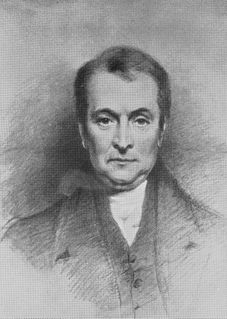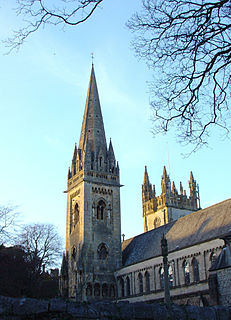
Mary Anning was an English fossil collector, dealer, and palaeontologist who became known around the world for finds she made in Jurassic marine fossil beds in the cliffs along the English Channel at Lyme Regis in the county of Dorset in Southwest England. Her findings contributed to changes in scientific thinking about prehistoric life and the history of the Earth.
William John Conybeare was an English vicar, essayist and novelist.

John Kidd was an English physician, chemist and geologist. Kidd was born in Westminster, the son of a naval officer and was educated at Christ Church, Oxford.

William Phillips FGS FRS was an English mineralogist and geologist.
The year 1787 in science and technology involved some significant events.

William Daniel Conybeare FRS, dean of Llandaff, was an English geologist, palaeontologist and clergyman. He is probably best known for his ground-breaking work on marine reptile fossils in the 1820s, including important papers for the Geological Society of London on ichthyosaur anatomy and the first published scientific description of a plesiosaur.

Frederick Cornwallis Conybeare, was a British orientalist, Fellow of University College, Oxford, and Professor of Theology at the University of Oxford.
Conybeare is a surname. Notable people with the surname include:
Events from the year 1787 in Great Britain.
This article is about the particular significance of the year 1787 to Wales and its people.

Dean of Llandaff is the title given to the head of the chapter of Llandaff Cathedral, which is located in Llandaff, Cardiff, Wales. It is not an ancient office – the head of the chapter was historically the Archdeacon who appears in this role in the Liber Landavensis and in the Chapter Acts preserved in the Glamorgan Records Office – but the office of a separate Dean was established by act of parliament in 1843. A century later the Deanery was merged with the Vicarage of Llandaff. The Chapter forfeited its legal rights on Disestablishment in 1920. The previous Dean was Janet Henderson.
A system in stratigraphy is a unit of rock layers that were laid down together within the same corresponding geological period. The associated period is a chronological time unit, a part of the geological time scale, while the system is a unit of chronostratigraphy. Systems are unrelated to lithostratigraphy, which subdivides rock layers on their lithology. Systems are subdivisions of erathems and are themselves divided into series and stages.

John Conybeare DD was Bishop of Bristol and one of the most notable theologians of the 18th century.

Duria Antiquior, a more ancient Dorset, was the first pictorial representation of a scene of prehistoric life based on evidence from fossil reconstructions, a genre now known as paleoart. The first version was a watercolour painted in 1830 by the English geologist Henry De la Beche based on fossils found in Lyme Regis, Dorset, mostly by the professional fossil collector Mary Anning. De la Beche had the professional artist Georg Scharf produce lithographic prints based on the painting, which he sold to friends to raise money for Anning's benefit. It was the first depiction of a scene from deep time to see even limited publication. The print was used for educational purposes and widely circulated in scientific circles; it influenced several other such depictions that began to appear in both scientific and popular literature. Several later versions were produced.
Elizabeth Philpot (1780–1857) was an early 19th-century British fossil collector, amateur palaeontologist and artist who collected fossils from the cliffs around Lyme Regis in Dorset on the southern coast of England. She is best known today for her collaboration and friendship with the well known fossil hunter Mary Anning. She was well known in geological circles for her knowledge of fossil fish as well as her extensive collection of specimens and was consulted by leading geologists and palaeontologists of the time including William Buckland, and Louis Agassiz. When Mary Anning discovered that belemnite fossils contained ink sacks, it was Philpot who discovered that the fossilised ink could be revivified with water and used for illustrations, which became a common practice for local artists.

St Mary, Itchen Stoke, Hampshire, is a redundant Anglican church in the parish of Itchen Stoke and Ovington. It has been designated by English Heritage as a Grade II* listed building, and is under the care of the Churches Conservation Trust.
Henry Conybeare was an English civil engineer and Gothic revival architect who designed two notable churches and greatly improved the supply of drinking water to Mumbai.

Mary Morland Buckland was an English palaeontologist, marine biologist and scientific illustrator.
This page is based on this
Wikipedia article Text is available under the
CC BY-SA 4.0 license; additional terms may apply.
Images, videos and audio are available under their respective licenses.









